
Section 12. Thematic reviews
12.2. Progress in Integrated Water Resources Management and Transboundary Water Cooperation in Central Asia (SDG 6.5)
Prepared by D. Ziganshina (SIC ICWC)
This survey is a part of Thematic Review series published in the Water Yearbook: Central Asia and Around the Globe that track progress in achieving the Sustainable Development Goals in Central Asia. Given issue reviews the progress made by the CA countries in integrated water resources management (IWRM) and transboundary water cooperation under SDG 6.5.
SDG 6.5 is formulated as follows: by 2030, implement integrated water resources management at all levels, including through transboundary cooperation as appropriate. To monitor progress in achieving this goal, SDG 6.5.1 tracks the degree of IWRM implementation, while SDG 6.5.2 considers the percentage of transboundary basin area within a country that has an operational arrangement for water cooperation.
Globally, the UN-Water Integrated Monitoring Initiative for SDG 6 (IMI-SDG6) coordinates reporting on SDG6 (IMI-SDG6). As the custodian of SDG indicator 6.5.1, the United Nations Environment Programme (UNEP) established a specialized IWRM technical support service, which developed the 2023 Monitoring guide. The United Nations Economic Commission for Europe (UNECE) and the United Nations Educational, Scientific and Cultural Organization (UNESCO) are the custodians of SDG indicator 6.5.2. They developed the Step-by-step monitoring methodology for SDG indicator 6.5.2 (2020 version) and the Guide to reporting under this indicator .
Globally, the degree of IWRM implementation is 54% (SDG indicator 6.5.1, 2020)
This summary report is based on formal country reporting verified by the UN custodian organizations (UNECE, UNESCO, and UNEP) within the reporting rounds 2017 and 2020.
Hopefully this summary will help the countries prepare their reports under the third reporting round 2023 and allow identifying issues that need assistance of development partners.
Progress in IWRM at all levels (SDG indicator 6.5.1)
186 countries submitted their national reports on indicator 6.5.1 in 2017 and 2020. All the CA countries also submitted their reports on this indicator in 2020. The degree of IWRM implementation is assessed through the four key components: (1) enabling environment; (2) institutions and participation; (3) management instruments; and, (4) financing.
In 2020, given the maximum score of 100, Kazakhstan (46), Tajikistan (46) and Uzbekistan (48) showed medium-low degree of IWRM implementation, while Kyrgyzstan was close to low degree (31) and Turkmenistan (64) reported on medium-high degree. Two countries that submitted national reports in 2017 demonstrated progress: Kazakhstan improved the overall indicator from low to medium-low, whereas Uzbekistan added three scores to its medium-low status (Table 1). Overall, the CA countries, except for Turkmenistan, show the lower than global (54) degree of IWRM implementation.
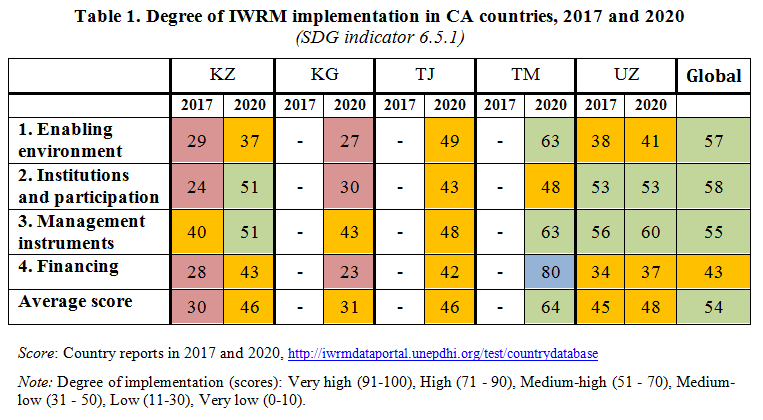
Under component 1, the countries assess their efforts in creating enabling environment for IWRM as low (Kyrgyzstan), medium-low (Kazakhstan, Tajikistan and Uzbekistan) and medium-high (Turkmenistan). Tajikistan and Turkmenistan rate their national water policies, laws and plans as medium-high (50-60). In turn, Uzbekistan gives medium-high score to its national water policy (60) but is not satisfied with laws and plans to support IWRM (30). Kazakhstan is even more dissatisfied with the status of laws and plans (20). Kyrgyzstan considers it achieved medium-low results (40-50) in policies and laws, and much more needs to be done in planning (20 of 100). Responses on sub-national strategies and regulations demonstrate the importance of focusing on this level in all CA countries, except for Turkmenistan. Arrangements for transboundary water management (1.2.c) have got high or medium scores in all the countries, except for Kyrgyzstan (30), which considers them unsatisfactory (Table 2).
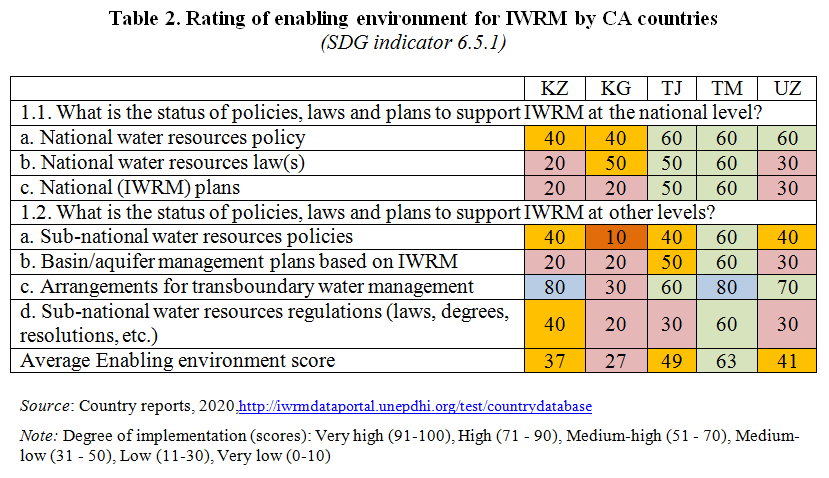
Under component 2, capacities and participation of institutions and other stakeholder groups that help to support implementation, including institutional capacity and effectiveness, inter-sectoral coordination, stakeholder participation and gender equality in the CA countries, are assessed as low (Kyrgyzstan), medium-low (Tajikistan and Turkmenistan), and medium-high (Kazakhstan and Uzbekistan) (Table 3).
Business participation in water resources development and management and organizational framework for transboundary water management were assessed as very high by Kazakhstan and high by Turkmenistan. Kazakhstan also gives high rating to public participation at national and sub-national levels, while Turkmenistan assesses as high its basin organizations and sub-national authorities. Kyrgyzstan gives medium-low rating to its institutions at national level and is not satisfied with progress at the sub-national level. Tajikistan gave high scores to national government authorities’ capacity for leading implementation of IWRM (60) and organizational framework for transboundary water management (60). Overall, Uzbekistan assesses the status of institutions for IWRM implementation at the national and other levels as medium-low or medium-high.
Kazakhstan is highly dissatisfied with absence of gender-specific aspects in water laws and plans. Judging from low scores, this is an issue in all the countries. Participation of business and sub-national authorities in planning processes in Kyrgyzstan, the public at the local level in Turkmenistan, and vulnerable groups in Tajikistan and Turkmenistan are rated as critically low.
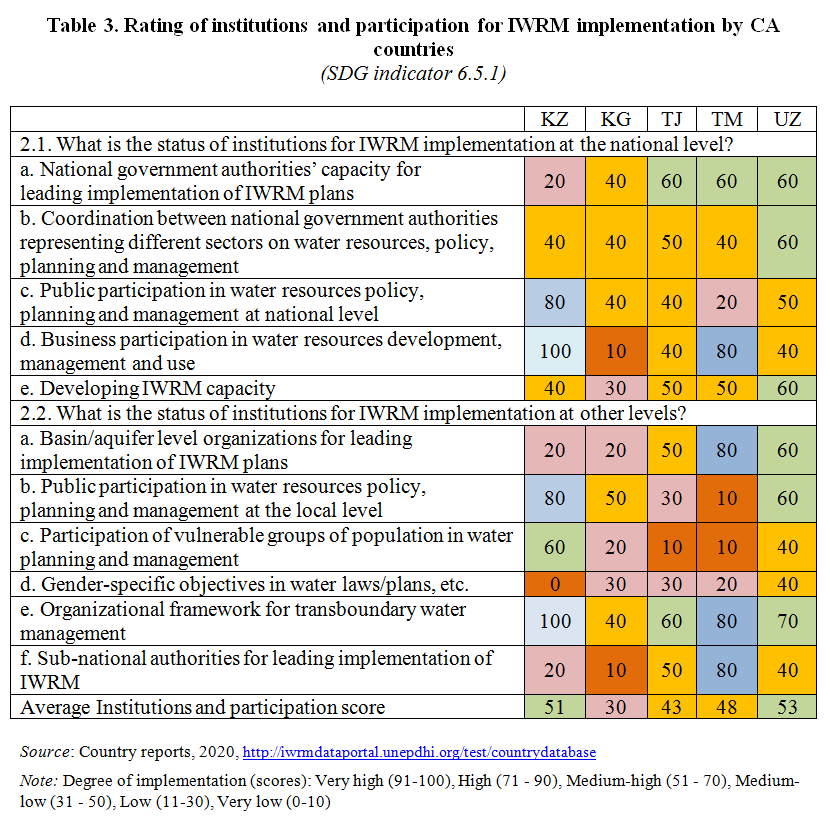
Assessment of management instruments that enable decision makers and users to make rational and informed choices between alternative actions (Component 3) generally is medium-high (Kazakhstan, Turkmenistan and Uzbekistan) or medium-low (Kyrgyzstan and Tajikistan). Such instruments include management programs, water resources and their load monitoring, knowledge sharing and capacity building (Table 4).
Only Kyrgyzstan expressed deep concern about management instruments at basin level. High scores (80) again were given by Kazakhstan and Turkmenistan to transboundary data and information sharing between countries. Turkmenistan is also satisfied with data and information sharing within the country at all levels.

Under component 4, the status of financing for water resources development and management is assessed as low (Kyrgyzstan), medium-low (Kazakhstan, Tajikistan and Uzbekistan) and high (Turkmenistan). Kazakhstan and Turkmenistan gave the highest score to their efforts for financing transboundary cooperation. Virtually all the countries, except for Turkmenistan, express particular concerns about the status of financing for water resources development and management at sub-national or basin level (Table 5).
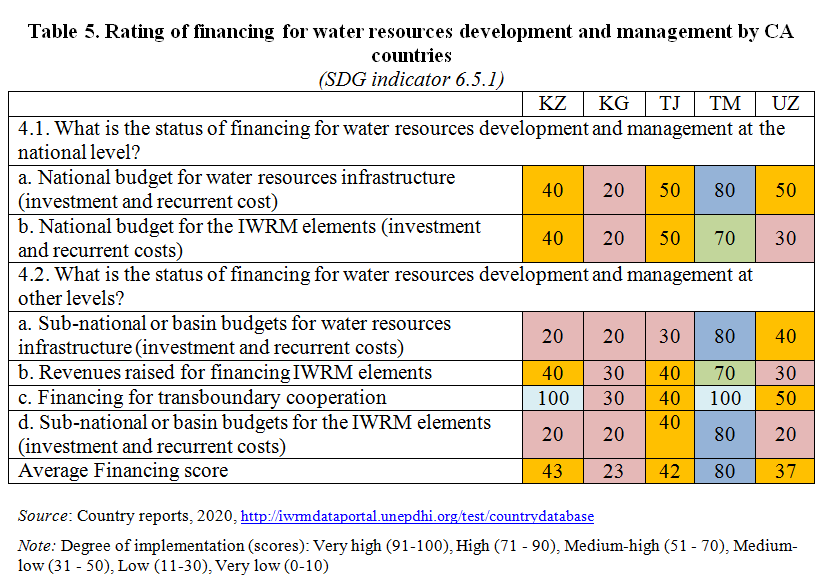
Progress in transboundary water cooperation (SDG indicator 6.5.2)
Indicator 6.5.2 looks at the area of a country within transboundary basins and assesses the extent to which that area is covered by operational cooperation arrangements. “Arrangement” refers to a bilateral or multilateral treaty, convention, agreement or other arrangement between riparian States that provides a framework for cooperation on transboundary water management. For an arrangement for cooperation between the riparian States to be considered operational, the following four criteria need to be in place: (1) there is a joint body or mechanism in place; (2) there are regular (at least once per year) meetings between riparian countries; (3) a joint or coordinated water management plan or joint objectives have been established; and, (4) regular exchanges (at least once per year) of data and information take place.
There are 286 transboundary river and lake basins and 592 transboundary aquifer systems in the world. According to data of the 2023 reporting round, only 24 countries of 153 countries comprising transboundary rivers, lakes and/or aquifers have 100% of their transboundary basin area covered by operational arrangements. From the 2020 reporting results, the global indicator of the percentage of transboundary basin area in a country covered by an operational arrangement of transboundary cooperation is 58%. The average value for this indicator is 65% in relation to transboundary river and lake basins (data from 115 countries) and 42% in relation to transboundary aquifers (for available 94 countries).
On average, 58% of transboundary basin area within a country is covered by operational arrangements for water cooperation (SDG indicator 6.5.2, 2022)
Meanwhile, 100% of tranboundary river or lake basin area in Kazakhstan and Uzbekistan, 66%, in Turkmenistan, and 30% in the Kyrgyz Republic are covered by operational arrangements for cooperation, i.e. there is a joint body, mechanism or commission for transboundary cooperation; riparian states meet regularly (at least once per year) at political or technical levels; joint objectives, strategy, joint or coordinated management or action plan are established by riparian states; and, there is regular exchange (at least once per year) of data and information (Table 6).

These results are consistent with those on transboundary cooperation under SDG indicator 6.5.1. As mentioned earlier, arrangements for transboundary water management (1.2.c.) and organizational framework for transboundary water management (2.2.e.) had very high or medium-high rating in all the countries, except for Kyrgyzstan. Kazakhstan and Turkmenistan are satisfied with transboundary data and information sharing, while other countries consider the latter as medium-low (Table 7).
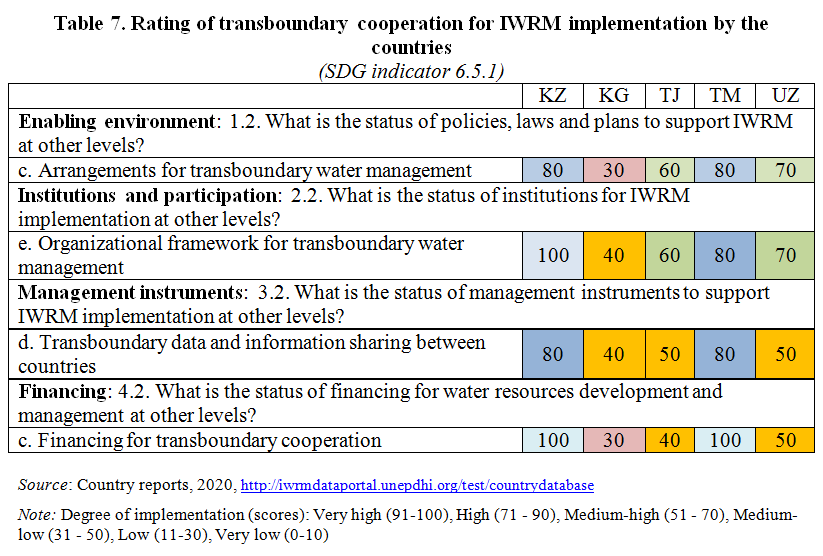
The status of financing for transboundary cooperation is assessed as very high by Kazakhstan and Turkmenistan, medium-low by Tajikistan and Uzbekistan and low by Kyrgyzstan. Generally, two downstream countries – Kazakhstan and Turkmenistan – are more satisfied with the status of transboundary cooperation. One should not that this assessment refers to cooperation not only within the Aral Sea basin but also within other basins to which these countries are riparian.
The global value for the aquifer component of the indicator is 42% as of 2020 (Table 6) that is lower than the overall value of this indicator (58%). The data on aquifers were reported by lower countries. This reflects that there is lack of knowledge and understanding of physical characteristics of transboundary aquifers in riparian states and the cooperation arrangements for aquifers are limited.
Kazakhstan, Kyrgyzstan, and Uzbekistan reported the data on aquifers in 2020, while Kazakhstan submitted such data in 2017 also. The aquifer component value of the indicator is ‘0’ in all the cases that means that no groundwater is covered by operational arrangements.
Conclusion and next steps
The CA countries and the world in general shall make much more efforts to achieve SDG 6.5, namely by 2030, implement IWRM at all levels, including through transboundary cooperation as appropriate. As of 2020, the value of indicator 6.5.1 is lower than 50 in all CA countries, except for Turkmenistan. It is necessary to accelerate progress twice and even more in some cases.
Ensure timely and better quality reporting. In the first reporting round, country reports on SDG indicator 6.5.2 were submitted by Kazakhstan, Turkmenistan and Uzbekistan but the indicator value was verified for Kazakhstan and Uzbekistan only. In the second reporting round, Kyrgyzstan also submitted its report and reporting was improved by Kazakhstan, Turkmenistan and Uzbekistan. Country engagement in workshops organized by UNECE and UNESCO, as well as supporting guidance material, strengthened the quality of reporting. Submission of country report by Tajikistan in the third reporting round would help to have a more comprehensive picture of the status of cooperation in Central Asia. As to indicator 6.5.1, all CA countries submitted their reports in the second monitoring round as compared to the first round, when only Kazakhstan and Uzbekistan submitted reports.
Revise priority areas. Monitoring through good quality and regular reporting informs countries and development partners of where to focus efforts. In particular, monitoring of SDG indicator 6.5.1 in CA countries demonstrates the need to focus on the following areas:
a) planning processes at all levels;
b) IWRM implementation at sub-national and/or basin levels;
c) building capacities in gender mainstreaming;
d) enhanced engagement of stakeholders, including the public and vulnerable groups in IWRM processes;
e) national monitoring of water availability and data sharing at all levels within a country;
f) management instruments at aquifer level;
g) financing for all levels.
Globally, in addition to tracking implementation of individual components, development of national IWRM Action Plans is encouraged. The SDG 6 IWRM Support Programme offers technical and financial support in developing such a plan (sdg6iwrmsp@gwp.org). The available IWRM Action Plans can be checked on theа Results Map.
Monitoring of transboundary water cooperation indicators revealed general positive trend and satisfaction of the countries in this area, except for Kyrgyzstan. As to river or lake basins, the fuller coverage by operational arrangements is demonstrated by Kazakhstan and Uzbekistan. According to the second monitoring round, Uzbekistan increased the indicator from 59.3 до 100% by viewing cooperation under umbrella of the ICWC, which fully covers the territories of Syr Darya and Amu Darya basins in Uzbekistan under its jurisdiction.
Nevertheless, significant data gaps still exist, especially in relation to transboundary aquifers in all the countries. The average value for indicator 6.5.2 could not be derived for Turkmenistan as the latter did not provided information on transboundary aquifers. Although Kazakhstan, Kyrgyzstan and Uzbekistan submitted data on transboundary aquifers, neither country reported on availability of any arrangement for transboundary aquifer. This indicates to a need to fill gaps in the data, especially on extent and dynamics of transboundary aquifers, and increase efforts to adopt arrangements for transboundary aquifers and ensure that all transboundary water bodies are covered by operational arrangements by 2030. These efforts should be backed by capacity building in transboundary water assessment.
Enhance cooperation between the countries in the process of national reporting in relation to transboundary aspects. While SDG indicator 6.5.2 invites countries to submit national reports, first and second reporting rounds in 2017/2018 and 2020/2021 showed benefits of coordination between countries when completing these reports. Coordination allows countries to improve the overall quality of data, reach a common understanding of the challenges, opportunities and priorities for a water body, and provides an opportunity for countries to set common targets, such as the development of a new or revised agreement, the establishment or reinvigoration of a joint institutional body, or the adoption of a basin management plan. UNECE and UNESCO made recommendations to consider the possibility of such coordination in the third reporting exercise, 2023, on SDG indicator 6.5.2. Enhanced cooperation between the CA countries in the recent years allowed the countries speak with one voice at COP conferences in Glasgow (2021) and Sharm El Sheikh (2022) and during the UN Water Conference in New York (2023).
ICWC as the mechanism of water cooperation operating for over 30 years could be a coordination platform on SDG indicator 6.5.2 for the CA countries.
National coordinators of indicators play a critical role. In most countries, coordinators are related to ministries which are responsible for water management. The coordinator bears overall responsibility for organization of monitoring, including stakeholder consultations and reporting. If necessary, they may apply to technical support services: UNEP (iwrmsdg651@un.org), on SDG indicator 6.5.1 and UNECE (transboundary_water_cooperation_reporting@un.org) and UNESCO (transboundary_water_cooperation_reporting@unesco.org) on SDG indicator 6.5.2.